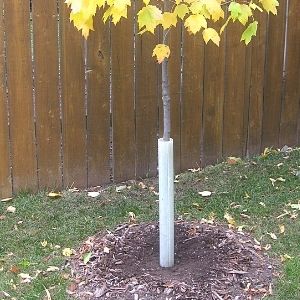Animals nibbling on the bark of a tree and/or the underlying live tissue (cambium) can greatly reduce, or even stop the transportation of water and nutrients from the roots to the leaves, causing serious, long-term damage. Sometimes, when food becomes scarce, like in late winter, animals seek out sustenance by feeding on the trunks, branches and winter foliage of young trees and shrubs. Never try to deter wildlife through inhumane methods, such as poisoning or trapping. Live trapping and relocation is also inhumane, since you may be separating mothers from babies and/or causing deadly territorial conflicts in the new locations. Instead, try the following humane methods to minimize animal damage when trees and shrubs are young and vulnerable!
Tree guards - Applying a tree guard is a quick and easy way to protect your tree from chewing. Tree guards should be retractable and breathable, allowing room for your tree to grow naturally. Be sure to remove all tree guards in the spring when temperatures start to increase to avoid moisture build up along the trunk, which can lead to decay.
Fencing - If you find you need more protection from chewing animals, such as rodents or rabbits, you can install chicken wire fencing around the outside of the mulch ring of your tree or shrub. Bury the fence a few inches into the ground to prevent animals from crawling underneath, while also taking care not to damage the roots. Make sure it is tall enough (about two to three feet) to protect against hopping critters, like rabbits.
Decoys – Purchasing decoy birds, such as owls or eagles, and placing them near your trees and shrubs is another way to deter animals from your yard. Colourful windmills are also an option as they move in the wind and can sometimes be more effective than decoys that are motionless. Whichever decoy you choose, be sure to change the location often, so that the animals don’t catch on to this trick! And remember to remove them once your tree or shrub gets big enough to withstand some animal activity.
Mulch correctly - Mulch is important for tree health, but if piled up against the trunk of newly planted trees and shrubs, it can offer a hiding place for rodents and rabbits, which can then easily chew on the bark without notice. Prevent this by ensuring that mulch is never piled up against the trunk or stem. Spread mulch two to four inches thick in a doughnut shape, ensuring it doesn’t touch the base of your tree or shrub. Bonus – the doughnut shape also ensures that mulch does not hold moisture against the stem and cause decay.
Right tree, right place - Other wildlife-related tree damage can be caused by climbing animals, such as racoons and squirrels, seeking food, shelter or protection from a young tree. Young trees are flexible but, if they cannot support the animal’s weight, it can lead to snapping branches. Choosing the right planting location can help minimize this kind of damage! LEAF recommends planting trees at least five feet from fences and 10 feet from buildings with foundations.
Ultimately, if your tree or shrub has experienced extensive animal damage, it’s always best to have it assessed by a certified arborist to determine the chances for survival. For more information on caring for your trees and shrubs, visit the Tree Care section of our website!
Natasha Keshavjee is an ISA certified arborist and was the Residential Planting Programs Operations Supervisor at LEAF.
The #BackyardBiodiversity campaign is a partnership initiative with the Toronto Wildlife Centre and is supported by Ontario Power Generation.
LEAF offers a subsidized Backyard Tree Planting Program for private property. The program is supported by the City of Toronto, the Regional Municipality of York, the City of Markham, the Town of Newmarket, the Regional Municipality of Durham, the Town of Ajax, the City of Oshawa, the City of Pickering, the Township of Scugog, the Town of Whitby, Ontario Power Generation, Ontario Trillium Foundation and GrandTrees/Canadian Trees For Life.




